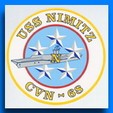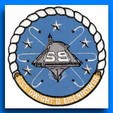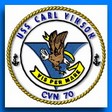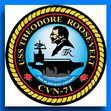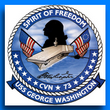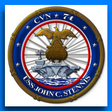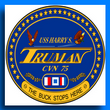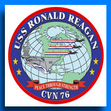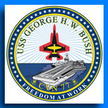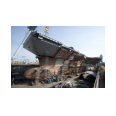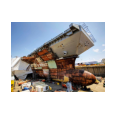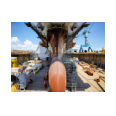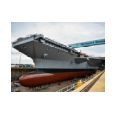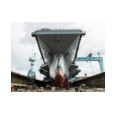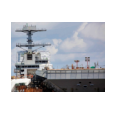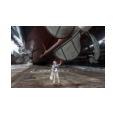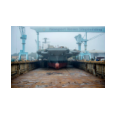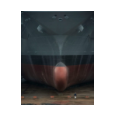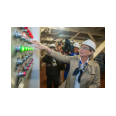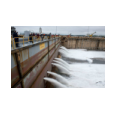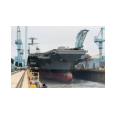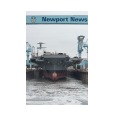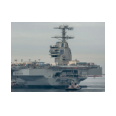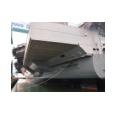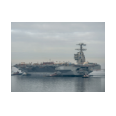| # | Name | Commissioned | Class | Status |
|---|---|---|---|---|
| CV-1 | Langley | 1922 | Langley-class, lead ship | Sunk February 1942 65 nm south of Cilacap, Java |
| CV-2 | Lexington | 1927 | Lexington-class, lead ship | Sunk May 1942 in the Battle of the Coral Sea |
| CV-3 | Saratoga | 1927 | Lexington-class | Sunk July 1946 in Operation Crossroads as a nuclear test target |
| CV-4 | Ranger | 1934 | Ranger-class, lead ship | Scrapped |
| CV-5 | Yorktown | 1937 | Yorktown-class, lead ship | Sunk June 1942 in the Battle of Midway |
| CV-6 | Enterprise | 1938 | Yorktown-class | Scrapped |
| CV-7 | Wasp | 1940 | Wasp-class, lead ship | Sunk September 1942 during the Guadalcanal campaign |
| CV-8 | Hornet | 1941 | Yorktown-class | Sunk October 1942 in the Battle of the Santa Cruz Islands |
| CV-9 b) | Essex | 1942 | Essex-class, lead ship | Scrapped |
| CV-10 b) | Yorktown | 1943 | Essex-class | Patriot's Point Naval & Maritime Museum-Mount Pleasant, South Carolina, USA |
| CV-11 b) | Intrepid | 1943 | Essex-class | Intrepid Sea-Air-Space Museum-New York, New York, USA |
| CV-12 b) | Hornet | 1943 | Essex-class | USS Hornet Museum-Alameda, California |
| CV-13 b) | Franklin | 1944 | Essex-class | Scrapped |
| CV-14 b) | Ticonderoga | 1944 | Long hull Essex-class | Scrapped |
| CV-15 b) | Randolph | 1944 | Long hull Essex-class | Scrapped |
| CV-16 d) | Lexington | 1943 | Essex-class | USS Lexington Museum On the Bay- Corpus Christi, Texas |
| CV-17 b) | Bunker Hill | 1943 | Essex-class | Scrapped |
| CV-18 b) | Wasp | 1943 | Essex-class | Scrapped |
| CV-19 | Hancock | 1944 | Long hull Essex-class | Scrapped |
| CV-20 b) | Bennington | 1944 | Essex-class | Scrapped |
| CV-21 c) | Boxer | 1945 | Long hull Essex-class | Scrapped |
| CVL-22 | Independence | 1943 | Independence-class light carrier, lead ship | Scuttled 1951 |
| CVL-23 | Princeton | 1943 | Independence-class | Sunk, October 1944, Battle of Leyte Gulf |
| CVL-24 | Belleau Wood | 1943 | Independence-class | Scrapped |
| CVL-25 | Cowpens | 1943 | Independence-class | Scrapped |
| CVL-26 | Monterey | 1943 | Independence-class | Scrapped |
| CVL-27 | Langley | 1943 | Independence-class | Scrapped |
| CVL-28 | Cabot | 1943 | Independence-class | Scrapped |
| CVL-29 | Bataan | 1943 | Independence-class | Scrapped |
| CVL-30 | San Jacinto | 1943 | Independence-class | Scrapped |
| CV-31 b) | Bon Homme Richard | 1944 | Essex-class | Scrapped |
| CV-32 b) | Leyte | 1946 | Long hull Essex-class | Scrapped |
| CV-33 b) | Kearsarge | 1946 | Long hull Essex-class | Scrapped |
| CV-34 | Oriskany | 1950 | Long hull Essex-class | Scuttled as an artificial reef, May 2006 in the Gulf of Mexico |
| CV-35 | Reprisal |
Canceled (August 11, 1945) |
Long hull Essex-class | Canceled |
| CV-36 b) | Antietam | 1945 | Long hull Essex-class | Scrapped |
| CV-37 c) | Princeton | 1945 | Long hull Essex-class | Scrapped |
| CV-38 b) | Shangri-la | 1944 | Long hull Essex-class | Scrapped |
| CV-39 b) | Lake Champlain | 1945 | Long hull Essex-class | Scrapped |
| CV-40 b) | Tarawa | 1945 | Long hull Essex-class | Scrapped |
| CVB-41 a) | Midway | 1945 | Midway-class, lead ship | USS Midway Museum-San Diego, California, USA |
| CVB-42 a) | Franklin D. Roosevelt | 1945 | Midway-class | Scrapped |
| CVB-43 a) | Coral Sea | 1947 | Midway-class | Scrapped |
| CVB-44 | Canceled | Midway-class | Canceled | |
| CV-45 c) | Valley Forge | 1946 | Long hull Essex-class | Scrapped |
| CV-46 | Iwo Jima |
Canceled (August 11, 1945) |
Long hull Essex-class | Canceled |
| CV-47 b) | Philippine Sea | 1946 | Long hull Essex-class | Scrapped |
| CVL-48 | Saipan | 1946 | Saipan-class, lead ship | Scrapped |
| CVL-49 | Wright | 1946 | Saipan-class | Scrapped |
| CV-50 | Canceled | Long hull Essex-class | Canceled | |
| CV-51 | Canceled | Long hull Essex-class | Canceled | |
| CV-52 | Canceled | Long hull Essex-class | Canceled | |
| CV-53 | Canceled | Long hull Essex-class | Canceled | |
| CV-54 | Canceled | Long hull Essex-class | Canceled | |
| CV-55 | Canceled | Long hull Essex-class | Canceled | |
| CVB-56 | Canceled | Midway-class | Canceled | |
| CVB-57 | Canceled | Midway-class | Canceled | |
| CVA-58 | United States |
Canceled (April 18, 1949) |
United States-class, lead ship | Canceled |
| CV-59 | Forrestal | 1955 | Forrestal-class supercarrier, lead ship | Decommissioned, awaiting disposal-Docked at NISMF, Philadelphia, PA |
| CV-60 | Saratoga | 1956 | Forrestal-class supercarrier | Decommissioned, awaiting disposal-Docked at NS Newport, RI |
| CV-61 | Ranger | 1957 | Forrestal-class supercarrier | Decommissioned, on donation hold-Docked at NISMF, Bremerton, WA |
| CV-62 | Independence | 1959 | Forrestal-class supercarrier | Decommissioned, awaiting disposal-Docked at NISMF, Bremerton, WA |
| CV-63 | Kitty Hawk | 1961 | Kitty Hawk-class supercarrier, lead ship | Decommissioned, In Reserve until 2015-Docked at NISMF, Bremerton, WA |
| CV-64 | Constellation | 1961 | Kitty Hawk-class supercarrier | Decommissioned, awaiting disposal-Docked at NISMF, Bremerton, WA |
| CVN-65 | Enterprise | 1961 | Enterprise-class supercarrier, lead ship | Active |
| CV-66 | America | 1965 | Kitty Hawk-class supercarrier | Decommission in 1995 and scuttled in 2005 |
| CV-67 | John F. Kennedy | 1968 | Kennedy-class supercarrier, lead ship | Decommissioned in 2007, on donation hold-Docked at NISMF, Philadelphia, PA |
| CVN-68 | Nimitz | 1975 | Nimitz-class supercarrier, lead ship | Active |
| CVN-69 | Dwight D. Eisenhower | 1977 | Nimitz-class supercarrier | Active |
| CVN-70 | Carl Vinson | 1981 | Nimitz-class supercarrier | Active |
| CVN-71 | Theodore Roosevelt | 1986 | Nimitz-class supercarrier | Active |
| CVN-72 | Abraham Lincoln | 1989 | Nimitz-class supercarrier | Active |
| CVN-73 | George Washington | 1992 | Nimitz-class supercarrier | Active |
| CVN-74 | John C. Stennis | 1995 | Nimitz-class supercarrier | Active |
| CVN-75 | Harry S. Truman | 1998 | Nimitz-class supercarrier | Active |
| CVN-76 | Ronald Reagan | 2003 | Nimitz-class supercarrier | Active |
| CVN-77 | George H.W. Bush | 2009 | Nimitz-class supercarrier | Active |
| CVN-78 | Gerald R. Ford | 2015 | Ford-class supercarrier, lead ship | Keel laid |
| CVN-79 | unnamed | 2019 | Ford-class supercarrier | Planned: A petition has also been set up for CVN-79 to be named as the ninth "USS Enterprise" after projected retirement of CVN-65 Enterprise in 2013. |
| CVN-80 | unnamed | 2023 | Ford-class supercarrier | Planned |
American Aircraft Carriers - Nimitz Class
Aircraft Carriers - CV/CVN
-
a): converted for jets, CVA, 1952
-
b): converted for jets, CVA, 1952. Converted to ASW, CVS, 1953-69
-
c): converted to amphibious command ship, LPH, 1959
-
d): converted for training, CVT, 1969
USS Nimitz (CVN-68)
Is a supercarrier in the United States Navy, the lead ship of her class. She is one of the largest warships in the world. She was laid down, launched and commissioned as CVAN-68, but was redesignated CVN 68 (nuclear-powered multimission aircraft carrier) on 30 June 1975 as part of the fleet realignment of that year.
The ship was named for World War II Pacific fleet commander Chester W. Nimitz, who was the Navy’s last fleet admiral. Unlike all subsequent Nimitz class carriers, Nimitz only uses her namesake's surname. She is also the only carrier of her class and the most recent supercarrier not to be named for someone who held elective office in the United States.
Nimitz was homeported at Naval Station Norfolk until 1987, when she was relocated to Puget Sound Naval Shipyard in Bremerton, Washington. After her mid-life overhaul and nuclear reactor refueling in 2001, Nimitz was relocated to NAS North Island, in San Diego, California.
General characteristics
Class and type: Nimitz-class aircraft carrier
Displacement: 100,000 long tons (110,000 short tons)
Length: Overall: 1,092 feet (332.8 m)
Waterline: 1,040 feet (317.0 m)
Beam: Overall: 252 ft (76.8 m)
Waterline: 134 ft (40.8 m)
Draft: Maximum navigational: 37 ft (11.3 m)
Limit: 41 ft (12.5 m)
Propulsion:
2 × Westinghouse A4W nuclear reactors
4 × steam turbines
4 × shafts
260,000 shp (194 MW)
Speed: 31.5 knots (58.3 km/h)
Range: Essentially unlimited distance; 20 years
Complement: Ship's company: 3,200
Air wing: 2,480
Sensors and processing systems:
AN/SPS-48E 3-D air search radar
AN/SPS-49(V)5 2-D air search radar
AN/SPQ-9B target acquisition radar
AN/SPN-46 air traffic control radars
AN/SPN-43C air traffic control radar
AN/SPN-41 landing aid radars
4 × Mk 91 NSSM guidance systems
4 × Mk 95 radars
Electronic warfare and decoys:
SLQ-32A(V)4 Countermeasures suite
SLQ-25A Nixie torpedo countermeasures
Armament: 2 × 21 cell Sea RAM
2 × Mk 29 Sea Sparrow
Armor: Classified
Aircraft carried: 90 fixed wing and helicopters
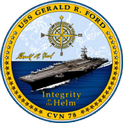 PCU Gerald R. Ford (CVN-78) is to be the lead ship of her class of United States Navy supercarriers. As announced by the U.S. Navy on 16 January 2007, the ship is named after the 38th President of the United States Gerald R. Ford, whose World War II naval service included combat duty aboard the light aircraft carrier Monterey in the Pacific Theater.
PCU Gerald R. Ford (CVN-78) is to be the lead ship of her class of United States Navy supercarriers. As announced by the U.S. Navy on 16 January 2007, the ship is named after the 38th President of the United States Gerald R. Ford, whose World War II naval service included combat duty aboard the light aircraft carrier Monterey in the Pacific Theater.
The keel of Gerald R. Ford was laid down on 13 November 2009. Construction began on 11 August 2005, when Northrop Grumman held a ceremonial steel cut for a 15-ton plate that forms part of a side shell unit of the carrier. She was christened on 9 November 2013. The schedule calls for the ship to join the U.S. Navy's fleet in 2016. Gerald R. Ford will enter the fleet replacing the inactive USS Enterprise (CVN-65), which ended her 51 years of active service in December 2012.
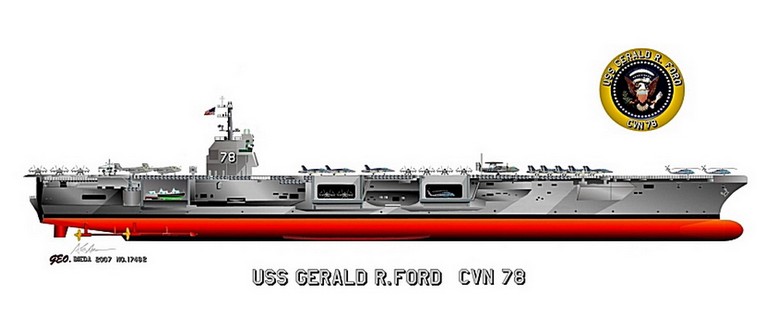
Name: USS Gerald R. Ford
Namesake: Gerald R. Ford
Awarded: 10 September 2008
Builder: Northrop Grumman Newport News
Laid down: 13 November 2009
Sponsored by: Susan Ford
Commissioned: est. 2015
Status: Under construction
General characteristics
Class & type: Gerald R. Ford-class aircraft carrier
Displacement: Approximately 100,000 long tons (110,000 short tons; 100,000 tonnes) (full load)
Length: 1,106 ft (337 m)
Beam: 256 ft (78 m)
Height: nearly 250 ft (76 m)
Decks: 25
Installed power: Two A1B nuclear reactors
Propulsion: Four shafts
Speed: In excess of 30 knots (56 km/h; 35 mph)
Range: Unlimited distance; 20-25 years
Complement: 4,660
Armament: Evolved Sea Sparrow Missile
Rolling Airframe Missile
Close-in weapons system (CIWS)
Aircraft carried: More than 75
Aviation facilities: 1,092 ft × 256 ft (333 m × 78 m) flight deck
Construction
On 10 September 2008, the U.S. Navy signed a $5.1 billion contract with Northrop Grumman Shipbuilding in Newport News, Virginia, to design and construct the carrier. Northrop had begun advance construction of the carrier under a $2.7 billion contract in 2005. The carrier is being constructed at the Huntington Ingalls (formerly Northrop Grumman) Newport News Shipbuilding facilities in Hampton Roads, Virginia, which employs 19,000 workers.
The keel of the new warship was ceremonially laid on 14 November 2009 in Dry Dock 12 by Ford's daughter, Susan Ford Bales. Said Bales in a speech to the assembled shipworkers and DoD officials: "Dad met the staggering challenges of restoring trust in the presidency and healing the nation's wounds after Watergate in the only way he knew how — with complete honesty and integrity. And that is the legacy we remember this morning."
As of August 2011, the carrier was reported to be "structurally halfway complete". In April 2012, it was said to be 75 percent complete. On 24 May 2012, the important milestone of completing the vessel up to the waterline was reached when the critical lower bow was lifted into place. This was the 390th of the nearly 500 lifts of the integral modular components (from which the vessel is assembled) that the ship's construction will ultimately require. On 8 October 2012, the carrier reached over the 88 percent of the complete structural construction. Huntington Ingalls reported (in an 8 Nov. 2012 GLOBE NEWSWIRE press release) that they have "Reached 87 percent structural completion of CVN-78 Gerald R. Ford". By 19 December 2012, construction had reached 90 percent structural completion. "Of the nearly 500 total structural lifts needed to complete the ship, 446 have been accomplished."
The island was originally scheduled to land in 2012. However, the island landing and ceremony actually took place on 26 January 2013.
On 9 April 2013, the flight deck of the carrier was completed following the addition of the ship's upper bow section, bringing the ship to 96 percent structural completion.
On 7 May 2013, the last of 162 superlifts was put in place, bringing the ship to 100 percent structural completion. Remaining work that needs to be done includes hull painting, shafting work, completion of electrical systems, mooring equipment, installation of radar arrays, and flooding of the dry dock.
On 11 July 2013, a time capsule was welded into a small room just above the floor, continuing a long Navy tradition. The time capsule holds items chosen by President Ford's daughter, Susan Ford Bales, and includes sandstone from the White House, Navy coins, and aviator wings from its first commanding officer.
The ship was originally scheduled for launch in July 2013 and delivery in 2015. Production delays meant that the launch had to be delayed until 11 October 2013 and the naming ceremony until 9 November 2013, with delivery in February 2016.
On 3 October 2013, Gerald Ford had four 30 ton, 21 ft (6.4 m)-diameter bronze propellers installed. The installation of the propellers required more than 10 months of work to install the underwater shafting.
On 11 October 2013, the ship's drydock was flooded for the first time in order to test various seawater-based systems. Her launch date was set to be on the same day as her naming ceremony on 9 November 2013.
On 9 November 2013, the ship was christened by Ford's daughter with a bottle of champagne.
As of 2013, construction costs are estimated at $12.8 billion, 22% over the 2008 budget, plus $4.7 billion in research and development costs. Because of budget difficulties, the Chief of Naval Operations, Admiral Jonathan Greenert, has warned there may be a two year delay beyond 2016 in completing Gerald R. Ford.
Performance improvements
Gerald R. Ford is intended to be the first of a class of aircraft carriers that offer significant performance improvements over the previous Nimitz-class aircraft carrier. Gerald R. Ford is equipped with an active electronically scanned array multi-function radar, and an island that is shorter in length and 20 feet (6.1 m) taller than that of the Nimitz-class; it is set 140 feet (43 m) further aft and 3 feet (0.91 m) closer to the edge of the ship. Electromagnetic catapults (EMALS) will launch aircraft, eliminating the need to store water and heat it for steam catapults. Gerald R. Ford can accomplish 25% more aircraft launches per day than the Nimitz-class and requires 25% fewer crew members. The Navy estimates it will save $4 billion in operating costs over a 50 year lifespan.
According to an Associated Press story:
"'She is truly a technological marvel,' Chief of Naval Operations Adm. Jonathan Greenert said in a webcast ceremony at the Newport News, Va., shipyard where Gerald R. Ford is being built. 'She will carry unmanned aircraft, joint strike fighters, and she will deploy lasers.'"
However these performance enhancers have proven problematic in Pentagon tests. In January 2014, the annual Director, Operational Test, and Evaluation (DOT&E) report said that critical ship systems including the EMALS, Advanced Arresting Gear (AAG), Dual Band Radar, and weapons elevators were not reliable enough and needed more testing and improvements. EMALS testing recorded 201 launch failures out of 1,967 launches, equaling a reliability rate of 240 mean cycles (launching of one aircraft) between critical failures. Testing of the AAG recorded 9 arresting failures out of 71 attempts, equaling a reliability rate of 20 mean cycles (recovery of one aircraft) between operational mission failure, a failure rate 248 times higher than should be expected. Those systems performed at a fraction of their requirements for shipboard configurations, and even less of required standards. Radar and weapons elevator test data was not made available, but were also below expectations. The Navy maintains that further testing will resolve the problems. Gerald R. Ford is projected to be able to generate 30 percent more sorties than Nimitz-class carriers, but the DOT&E report claims that is too optimistic, though the Navy also maintains that assumption based on modeling and simulations. Gerald R. Ford is planned to complete Initial Operational Test & Evaluation in 2017 before entering service.


